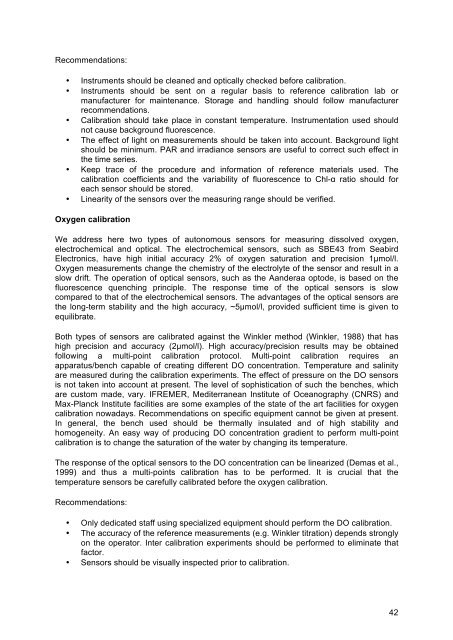Handbook of best practices
Handbook%20of%20best%20practices
Handbook%20of%20best%20practices
You also want an ePaper? Increase the reach of your titles
YUMPU automatically turns print PDFs into web optimized ePapers that Google loves.
Recommendations:<br />
• Instruments should be cleaned and optically checked before calibration.<br />
• Instruments should be sent on a regular basis to reference calibration lab or<br />
manufacturer for maintenance. Storage and handling should follow manufacturer<br />
recommendations.<br />
• Calibration should take place in constant temperature. Instrumentation used should<br />
not cause background fluorescence.<br />
• The effect <strong>of</strong> light on measurements should be taken into account. Background light<br />
should be minimum. PAR and irradiance sensors are useful to correct such effect in<br />
the time series.<br />
• Keep trace <strong>of</strong> the procedure and information <strong>of</strong> reference materials used. The<br />
calibration coefficients and the variability <strong>of</strong> fluorescence to Chl-α ratio should for<br />
each sensor should be stored.<br />
• Linearity <strong>of</strong> the sensors over the measuring range should be verified.<br />
Oxygen calibration<br />
We address here two types <strong>of</strong> autonomous sensors for measuring dissolved oxygen,<br />
electrochemical and optical. The electrochemical sensors, such as SBE43 from Seabird<br />
Electronics, have high initial accuracy 2% <strong>of</strong> oxygen saturation and precision 1μmol/l.<br />
Oxygen measurements change the chemistry <strong>of</strong> the electrolyte <strong>of</strong> the sensor and result in a<br />
slow drift. The operation <strong>of</strong> optical sensors, such as the Aanderaa optode, is based on the<br />
fluorescence quenching principle. The response time <strong>of</strong> the optical sensors is slow<br />
compared to that <strong>of</strong> the electrochemical sensors. The advantages <strong>of</strong> the optical sensors are<br />
the long-term stability and the high accuracy, ~5μmol/l, provided sufficient time is given to<br />
equilibrate.<br />
Both types <strong>of</strong> sensors are calibrated against the Winkler method (Winkler, 1988) that has<br />
high precision and accuracy (2μmol/l). High accuracy/precision results may be obtained<br />
following a multi-point calibration protocol. Multi-point calibration requires an<br />
apparatus/bench capable <strong>of</strong> creating different DO concentration. Temperature and salinity<br />
are measured during the calibration experiments. The effect <strong>of</strong> pressure on the DO sensors<br />
is not taken into account at present. The level <strong>of</strong> sophistication <strong>of</strong> such the benches, which<br />
are custom made, vary. IFREMER, Mediterranean Institute <strong>of</strong> Oceanography (CNRS) and<br />
Max-Planck Institute facilities are some examples <strong>of</strong> the state <strong>of</strong> the art facilities for oxygen<br />
calibration nowadays. Recommendations on specific equipment cannot be given at present.<br />
In general, the bench used should be thermally insulated and <strong>of</strong> high stability and<br />
homogeneity. An easy way <strong>of</strong> producing DO concentration gradient to perform multi-point<br />
calibration is to change the saturation <strong>of</strong> the water by changing its temperature.<br />
The response <strong>of</strong> the optical sensors to the DO concentration can be linearized (Demas et al.,<br />
1999) and thus a multi-points calibration has to be performed. It is crucial that the<br />
temperature sensors be carefully calibrated before the oxygen calibration.<br />
Recommendations:<br />
• Only dedicated staff using specialized equipment should perform the DO calibration.<br />
• The accuracy <strong>of</strong> the reference measurements (e.g. Winkler titration) depends strongly<br />
on the operator. Inter calibration experiments should be performed to eliminate that<br />
factor.<br />
• Sensors should be visually inspected prior to calibration.<br />
42


